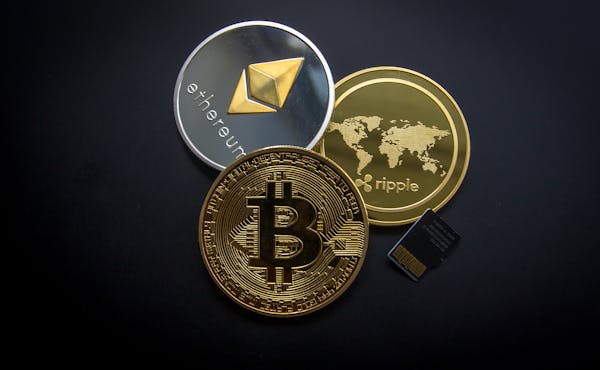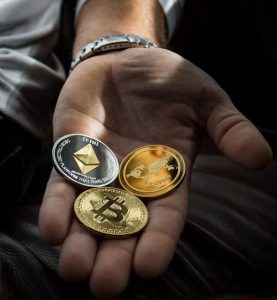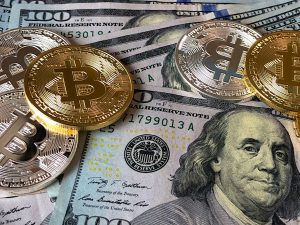
SafeMoon was designed to reward long-term holders and charges sellers a 10% fee, with part of that fee going back to existing holders.1 First launched on the Build and Build (BNB) chain in March 2021, SafeMoon can now be bought on some exchanges such as Pancakeswap.
Though some may claim SafeMoon is resistant to manipulation, others note the dramatic volatility and fall of SafeMoon’s price in 2022 as potentially unusual trading behavior. Investors should conduct thorough research before making all investment decisions, including and especially those involve cryptocurrencies.
- SafeMoon is a cryptocurrency launched in March 2021 with a unique tokenomics model that aims to reward holders and discourage short-term selling.
- It employs a deflationary mechanism where a portion of each transaction is redistributed to existing holders, encouraging them to keep their tokens, which theoretically helps stabilize the price.
- SafeMoon gained popularity due to its viral marketing and community-driven approach, attracting a large number of investors and enthusiasts.
- Critics argue that the project lacks transparency and real-world utility, with some concerns raised about the sustainability of its tokenomics model.
- As with any investment in the crypto space, potential investors should exercise caution, conduct thorough research, and be aware of the risks involved.
What Is SafeMoon?
Digital currencies are virtual assets, secured by cryptographic encryptions and powered by the distributed ledger technology known as the blockchain. Virtual currencies such as Bitcoin, Ethereum, and other stablecoins now serve as media of exchange globally. Investing in cryptocurrencies can be complicated since thousands of them exist but only a handful are real. As an investor, you should research the quality and realness of a coin before leaping.
Some distinct features of SafeMoon include the static reward where 50% of tokens from its transaction fees (usually 10%) are distributed to token holders, as well as the manual burn where the supply of SafeMoon tokens reduces to increase the price and demand. SafeMoon also has a self-sustaining liquidity pool that can siphon tokens in the form of fees, which are then added to the token’s liquidity pool on Pancakeswap.2
In the past year, some celebrities have invested and endorsed SafeMoon. They include social media personality and professional boxer Jake Paul, with a YouTube channel of over 20 million subscribers, who has claimed that investing in SafeMoon can make everyone rich in the long run. Others are Brett Ratner and DJ Afrojack.3
SafeMoon vs. SafeMoon V2
SafeMoon launched an updated SafeMoon token in December 2021.4 The updated token consolidates the original version in a ratio of 1:1000 while ensuring transactions cost lower.
If you hold original SafeMoon tokens in a wallet and choose to switch them to SafeMoon V2, it can only be done manually. The switching process is quite easy.
SafeMoon wallet users can update the app to the latest version and follow the instructions while those with other kinds of wallets can visit SafeMoon Swap to convert their tokens.
Additionally, if you hold your SafeMoon tokens on an exchange, you don’t have to switch to the V2 tokens. This is because the exchange handles the migration process and gives an update on the status of the process.
Compared to the original version, SafeMoon V2 processes transactions at a much lower cost. The V2 transaction fee is now 2% of the entire transaction.56
SafeMoon Fraud Allegations and Criticisms
It is important to note several allegations against SafeMoon as part of your research on deciding whether SafeMoon is the right investment for you.
In April 2022, Stephen “Coffeezilla” Findeisen accused the SafeMoon team of misappropriating millions of dollars. Findeisen found evidence of SafeMoon’s liquidity wallet moving funds to a wallet called the “Gabe (6abe) wallet,” which withdrew funds to a separate company run by John Karony. Thomas “Papa” Smith, former SafeMoon CTO, responded to Findeisen’s claims, stating that funds were taken from the “locked liquidity pool” before Karony’s appointment.7
In February 2022, a class-action lawsuit against SafeMoon was filed, alleging the company is a pump and dump scheme. Jake Paul, Nick Carter, Soulja Boy, Lil Yachty, and Ben Phillips were accused of promoting the SafeMoon token with misleading information. In May 2022, multiple SafeMoon investors filed another class action lawsuit for security fraud. The lawsuit was voluntarily terminated in November 2022.8
In December 2021, SafeMoon developed Version 2 of their token, SafeMoon V2, and set a deadline for token migration to avoid a 100% tax. They also introduced a decentralized exchange called “Safemoon Swap.” In April 2022, they introduced the Safemoon card, a 2.5% fee debit card for goods using SafeMoon and other cryptocurrencies. However, the card’s release has been delayed, causing criticism from experts.9
Advantages and Disadvantages of SafeMoon
Pros of SafeMoon
SafeMoon, like other cryptocurrencies, operates on decentralized blockchain technology. This means there is no central authority controlling or governing the network. Decentralization can enhance security, transparency, and censorship resistance, as no single entity has full control over the platform. Note that SafeMoon has received criticisms for manipulation, as even decentralized currencies can be controlled.
Part of SafeMoon’s transaction fee is added to the liquidity pool, which is essentially a smart contract holding a reserve of the token. This liquidity pool can provide stability to the token’s price by ensuring that there are funds available for trading even during periods of high volatility. The transaction fee that is distributed to existing token holders can incentivize people to hold their tokens. Long-term holders can benefit from increased token balances without having to actively participate in yield farming or staking.
While the primary focus of SafeMoon is not explicitly on yield farming or staking, the reflective tokenomics model can create opportunities for holders to earn passive income. Some users might choose to participate in yield farming on decentralized finance (DeFi) platforms that support SafeMoon or stake their tokens in protocols offering rewards.
Cons of SafeMoon
Despite several advantages, there remain a vast number of downsides to SafeMoon. The obvious downside of SafeMoon is the future public perception of the cryptocurrency. The success of SafeMoon, like many other cryptocurrencies, is heavily reliant on community sentiment. Because SafeMoon has faced several lawsuits and allegations of fraud, it remains to be seen whether the cryptocurrency will experience growth or strong user adoption in the future.
Cryptocurrencies, including SafeMoon, are known for their price volatility. Price fluctuations can occur rapidly and unpredictably, leading to significant gains for some investors but also substantial losses for others. This was most notably seen during the 2022 lawsuit filing when SafeMoon lost nearly all of its value.
Beyond speculative trading and holding for potential price appreciation, SafeMoon has limited practical use cases. Also, even though it has existed for several years, SafeMoon is a relatively new project compared to more established cryptocurrencies with undefined schedules and unproven roadmap execution.
Smaller cryptocurrencies like SafeMoon also might have limited liquidity compared to more established tokens. Though it does transmit some fees to liquidity pools, limited liquidity can make it difficult for holders to execute large trades at desired prices, making it possible but unprofitable to exist an investment position at times.
Last and perhaps most importantly, SafeMoon remains a speculative investment with an unproven business model that has yet to experience wide adoption. In certain contexts, SafeMoon may be seen as a “rug pull”, as many investors likely lost lots of money due to the legal ramifications of 2022. This is not to say future performance of SafeMoon may play out the same way; still, a downside of SafeMoon is the historical context of several price volatility leading to losses.
Pros
- Like many cryptocurrencies, exists on decentralized blockchain
- Operates a (relatively small) liquidity pool
- Operates a reflection mechanism which benefits long-term holders
- May present investors with DeFi opportunities
Cons
- Has experience material price volatility (without having rebounded close to all-time highs)
- Has experienced numerous fraud and legal allegations
- Has yet to materialize large-scale real-world uses
- Tends to demonstrate Ponzi-like features
- May be larger to sell due to smaller liquidity pools
- May have negative public sentiment due to media coverage of fraud (i.e. Coffeezilla coverage)
How to Buy SafeMoon
With this information in hand, should you still decide SafeMoon is the type of investment best suited for your portfolio, there are crypto exchanges where you can buy SafeMoon. Crypto exchanges are platforms where a diverse ecosystem of cryptocurrencies can be bought or sold. However, investors must understand that not all coins can be bought with fiat but with other coins. One such coin is SafeMoon as it isn’t listed on any centralized exchange that accepts fiat currency.
While SafeMoon isn’t available on the Coinbase or Binance centralized exchanges, you can still buy the tokens on these exchanges using the steps outlined below.
Step 1: Download the wallet and sign up
You can install your wallet on your computer or browser extension or directly download it via mobile app stores such as the Google Play Store or the Apple App Store. After downloading the wallet, you must set a username that should be kept safe.
Step 2: Securing your recovery phase
After downloading a wallet and setting up the username, a 12-word recovery phrase will be presented to you for safekeeping. This recovery phrase is a key to your crypto that helps you retain your wallet should your device get damaged or lost. Remember that you aren’t supposed to share this phrase with anyone. Writing it out and keeping it in a safe is ideal.
Step 3: Check to ensure you have enough Ethereum to cover fees
The cost of a transaction depends on how busy the Ethereum network is, how quickly you want the transaction to be processed, and the size of the transaction. Ethereum network fees are also known as gas fees.
Step 4: Buy and transfer Ethereum to the wallet
Once you have met the user verification requirement, you can transfer cash to your wallet and proceed to buy some Ethereum coins with it. After purchase, the Ether (ETH) coins will be stored in the Ethereum wallet.
Step 5: Use the Ether (ETH) to buy SafeMoon
With your ETH in the wallet, you can swap ETH coins for SafeMoon directly. All you need to do is click the “swap” icon in the assets tab, choose SafeMoon, and swap ETH for the value of SafeMoon you desire.
What You Need to Open a Cryptocurrency Exchange Account
There are several requirements needed to open an exchange account. For decentralized exchanges, the process is pretty simple: Download the software or browser extension, set up an account, and store your recovery phase.
For centralized exchanges, you are expected to meet the know-your-customer (KYC) verification requirement before being able to fund your account and trade. Things needed to open an exchange account are explained below.
Personal Information
Exchanges often mandate customers to provide their personal information to meet KYC requirements as mandated by regulatory authorities. Examples of personal information required include:
- Full name
- Means of Identification such as an International passport
- Proof of address such as utility bills
- Social Security number
- Others as required by the exchange
Minimum Deposits
Every exchange has a range of deposits that users must fund their accounts with. For example, Coinbase and Binance require users to deposit a minimum of $50 and $10, respectively, to complete their trades.1112
Types of Cryptocurrency Exchanges
Centralized Exchanges
Centralized exchanges are custodial platforms that enable users to exchange their crypto assets safely. Though secure, these exchanges take custody of a user’s private key which is needed to authorize transactions.
Authorities or businesses that control centralized exchanges have the sole right to make decisions regarding the platform. Centralized exchanges have sustainable liquidity as they can partner with platforms that provide them with liquidity.
Decentralized Exchanges
Decentralized exchanges are platforms that give users sole custody of their private keys and require the consent of the community to make key decisions regarding the platform.
Decentralized platforms eliminate the need for third parties, making transactions cheaper than centralized exchanges. Additionally, users risk losing access to their accounts should they lose their recovery phase.
Hybrid Exchanges
Hybrid exchanges are becoming quite popular. These exchanges combine the features of centralized and decentralized exchanges, allowing users to trade crypto seamlessly.
Best Cryptocurrency Exchanges
Factors to Consider When Opening a Cryptocurrency Exchange Account
As a crypto investor, there are factors you should consider when creating an exchange account. These factors include:
Security: With the current activities of fraudsters, exchanges that protect and update their security architecture constantly have high trading volumes. When opening an account, you should check if the platform has multi-layer verification for withdrawals, two-factor authentication, or if it’s custodial.
Fees: From buying fees to swapping and exchanging fees, it’s often advised to compare the best in the industry before making a choice. However, security should not be compromised.
Number and quality of coins supported: It’s important to check the number of coins an exchange supports, especially if you want to diversify your investment portfolio. Research the quality of coins in the exchange to avoid investing in scam tokens.
Wallet safety and quality: Before choosing an exchange, you should ensure it has a reputation for security.
Storage and custody: This feature has to do with if an exchange takes custody of your private keys or gives you the responsibility of holding them. Depending on your preferences, you may choose either a custodial or non-custodial wallet.
Centralized vs. Decentralized Exchanges
While centralized and decentralized exchanges exist to trade crypto assets, the difference is based on how they do it and their mode of operation. Factors that differentiate both include regulation, supported coins, liquidity, security, user experience, and custody.
While centralized exchanges are more regulated, support several coins, have more liquidity, are less secure, have a great user experience, and take custody of users’ private keys, decentralized exchanges are not.
Even though the crypto industry is at its early stage in terms of regulation, centralized exchanges are striving to comply with financial regulations. Regulation works to protect investors and their investments.
In November 2022, the world’s second-largest crypto exchange, FTX, collapsed and immediately filed for bankruptcy. Its books showed the exchange lacked tangible reserves and court filings alleged the exchange indiscriminately used customers’ funds for both operational and personal use.13
Being a centralized exchange, key decisions were taken without the knowledge of the community. To prevent issues such as this, decentralized exchanges may just be a great fit. These exchanges are built on-chain and all information regarding them is available to the public. Above all, decisions can only be made after token holders have voted in favor of them.
Though there may be a bit of controversy, SafeMoon works to encourage long-term investment and discourage selling by charging users a 10% fee, with 50% of this being distributed to existing SafeMoon users.14
SafeMoon can serve as a means of investment, especially if you plan to leverage the reward and incentivization program. To achieve this, use the SafeMoon Swap decentralized application on the Build and Build chain and swap BNB coins for SafeMoon tokens. Then simply hold the tokens to qualify for rewards from transaction fees generated by the platform.
Launched in 2021, SafeMoon is still relatively new, quite volatile with low trading volumes, and not listed on exchanges that accept fiat.4 These are signs that the token may be lacking in terms of regulation. Hence, it’s still quite early to say if the token is safe or not.
The Bottom Line
SafeMoon is a relatively new cryptocurrency with unique tokenomics featuring a 10% transaction fee that redistributes 5% to existing holders and adds 5% to the liquidity pool. It aims to incentivize long-term holding and price stability. However, it has seen its fair share of allegations of fraud, and investors are encouraged to do independent research before deciding whether to invest in SafeMoon.
The comments, opinions, and analyses expressed on Investopedia are for informational purposes online. Read our warranty and liability disclaimer for more info.



